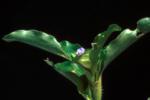Latin name
Commelina benghalensis L.
Family
Cyperaceae
Common name(s)
Tropical spiderwort
Synonym(s)
Commelina cavaleriei H. Lév.
Geographical distribution
Asia: China (including Taiwan) and Japan.
South and Southeast Asia: Bangladesh, India, Indonesia, Nepal, Pakistan, Philippines, Sri Lanka, Thailand, and Vietnam.
Rest of the world: Angola, Bolivia, Republic of Congo, Ethiopia, Kenya, Madagascar, Malawi, Mauritius, Namibia, Nigeria, Paraguay, Tanzania, Uganda, United States, Zambia, and Zimbabwe.
Morphology
A prostrate or ascending, 30—100—cm—long perennial or annual herb.
Stem: fleshy and rooting at nodes, cylindrical, hairy; basal portions often underground with reduced leaves and modified flowers.
Leaf: elliptic-ovate, hairy with parallel veins, helically arranged; 2.5—7.5—cm—long; petiole, 6—mm—long, fringed with short and long red hairs.
Inflorescence: spathe enclosing 3—4 violet-blue flowers with 3—4—mm—long green petals, funnel-shaped, compressed, about 1.5—cm—long and wide; some flowers produced from underground stems, whitish, remain unopened throughout their life.
Fruit: a 6—7—mm—long capsule with five seeds.
Seed: gray-black with a wrinkled surface; appears sugar-coated, 2—mm—long.
Biology and ecology
Favors moist, fertile soil conditions in sunny or lightly shaded locations. Common in upland fields, field margins, and open waste places. A single plant is able to spread over a large area because of its ability to produce adventitious roots at the nodes and its straggling habit.
It produces two kinds of flower (floral dimorphism), one on the stems aerially and the other from the underground stem. It also exhibits seed polymorphism, in which the aerial flower produces one large and four small seeds, whereas the underground flower produces one large and two small seeds. Aerial and underground flowers are perfect (bisexual) and can be self-pollinated. Reproduces by seed and vegetatively from underground stems.
Seedlings emerge after 10—12 days and take 35 days to reach the reproductive stage.
Agricultural importance
Forms dense stands that smother low-growing crops. It is an alternate host of nematodes, groundnut rosette virus, and leaf blotch. Used as a forage plant in Indonesia and the Philippines; leaves used for human consumption, and for treating sterility, wounds, sore eyes, burns, and sore throats.
Management
Cultural control: hand weeding can control this weed effectively.
Chemical control: butachlor as preemergence and propanil or 2,4-D or MCPA as postemergence treatments are used against C. benghalensis.
Selected references
Galinato MI, Moody K, Piggin CM. 1999. Upland rice weeds of South and Southeast Asia. Manila (Philippines): International Rice Research Institute. 156 p.Holm LG, Doll J, Holm E, Pancho J, Herberger J. 1996. World weeds: natural histories and distribution. John Wiley & Sons, Inc. USA. 1,129 p.Merrill ED. 1976. A flora of Manila. Manila (Philippines): Department of the Interior, Bureau of Science. 491 p.Moody K. 1989. Weeds reported in South and Southeast Asia. Manila (Philippines): International Rice Research Institute. 442 p.Pancho JV, Obien SR. 1995. Manual of ricefield weeds in the Philippines. Muñoz, Nueva Ecija (Philippines): Philippine Rice Research Institute. 543 p.
Contributors
JLA Catindig, RT Lubigan, and DE Johnson
